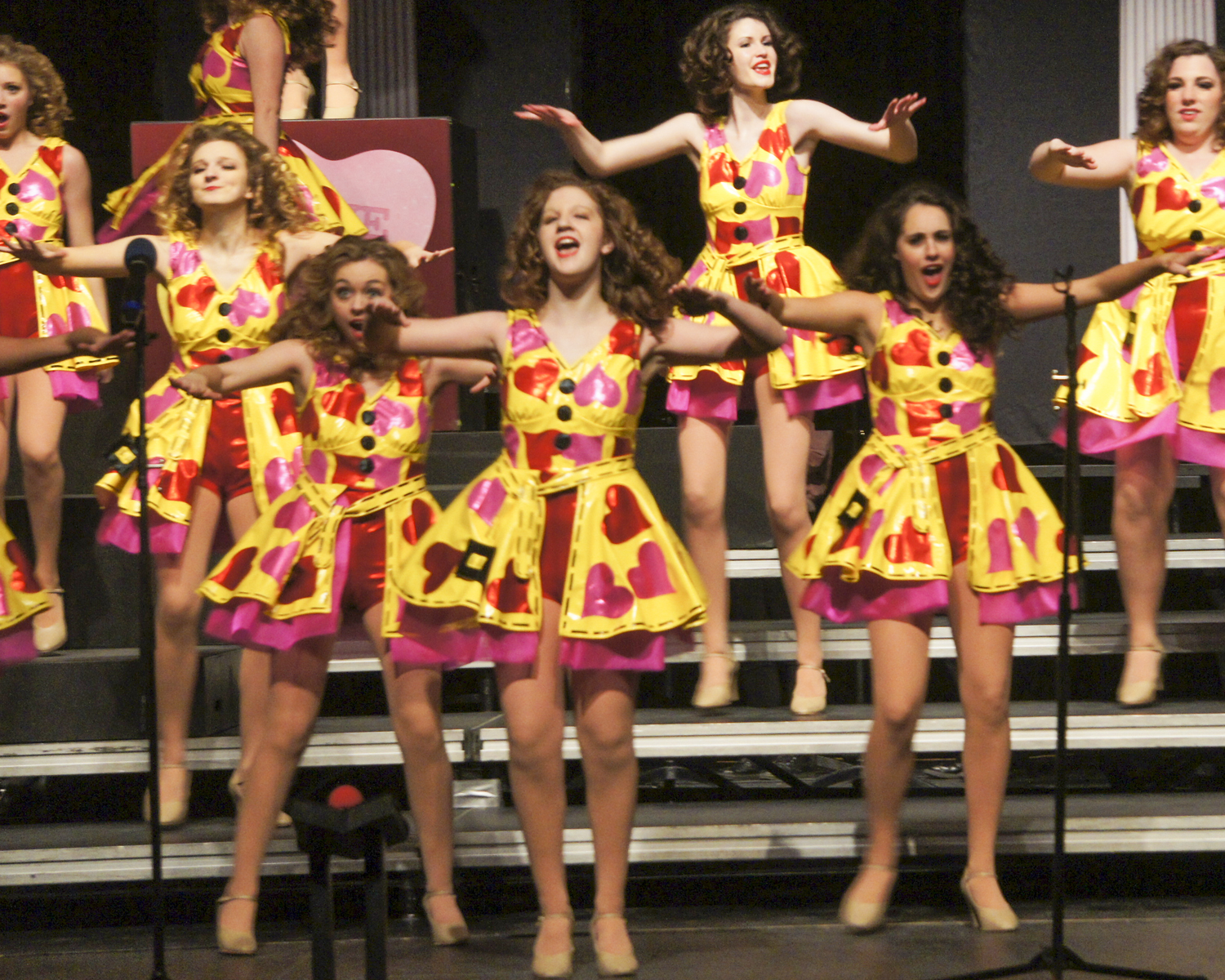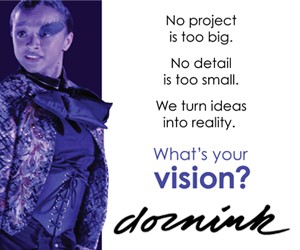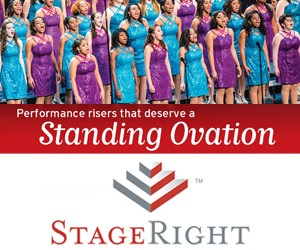
Some of the more scanty costumes literally use a bra or bustier and just stone the heck out of it, hoping no one in the audience will realize they are seeing underwear. Apparently, in this day and age, that can work-we have become fairly desensitized since 1980s Madonna, perhaps- but is it a wise or modest choice? Likely not. The better option is to cover the bra or bustier with fabric, and then decorate it. This will provide the best supportive costume and it will be, for lack of a better word, “proper.”
Maintaining Shape
The best starting point is to have the bust area of each of your female performer’s costume to fit her properly, which means that it contours to her individual bustline shape, hugging her bosom. If this part of the costume is created in a non-stretch fabric, it must be supportive; for instance, a prom-style dress manufactured in taffeta or in a woven satin must come with an extra layer of support and/or some boning, in order to maintain the intended shape of the costume.
Sometimes the costumes you find perfect for your set simply don’t correctly fit the bustline. When this happens, either the bodice can be altered with boning, which is fairly difficult, or the space can be filled with pre-made “cups” or pads. Adding what are known in the industry as “chicken cutlets,” “pierogis” or “biscuits”-nicknames for those polyester fiber-filled bust pads that fill and shape the bustline area-can be used. Do not forget, however, that you absolutely must have these “cups” pinned in or sewn in so they don’t make an escape during an especially rigorous dance move.
No One-Size-Fits-All Approach
With the varying shapes and sizes of bust pads, the only way to know what works best with any given garment is to have various styles on hand, and then experiment with what looks and feels best. Unfortunately, the one-size-fits-all approach definitely won’t work in this case.
If the costuming is spandex or some other stretchy material, you’ll likely need to create additional support, as the most minimal construction would offer only a thin layer of spandex. Of course, if that layer were tight enough, the support might be enough for a smaller bustline-but not for even an adult medium-sized bustline and most assuredly not for a larger bustline. At least a double layer of spandex is preferable, and a costume with a bustline that has darts or seaming that is shaped to form a tightly fitting cup is even a better option. Of course, adding additional bust pads could also help. Bras can be altered and adjusted to fit inside all types of open back, or nearly open backed garments. It is difficult to cut through under wires, but other than this, bras and corsets can be trimmed down to fit a neckline and the backs and/or straps can be cut away.
The Laws of Physics
The laws of physics will dictate what you can do, to substitute for cut away backs or straps. Generally areas can be filled in with stretch mesh or decorative (or my personal least favorite: utilitarian elastic straps) can be strategically placed, instead of the original bra straps. Plan to experiment with how to best create a bustline to support performers so they will feel comfortable with the result and look great as well.
While you are paging through numerous catalogs with front-only pictures and/or looking at samples of these costumes, think about better options for your dancers. Think about age appropriate costuming In regard to bust support. Can your female performers really concentrate on footwork, hand movements, and facial expressions if their breasts are not fully supported in their costumes? For comfort, proper support is needed. Our regular day-to-day clothing generally includes a bra, both for support of the breasts, and to help restrict the movement of the breasts during physical exercise. The sport bra was invented for the more extreme movements of rigorous sports. Some clothing has built-in bust support, such as swim suits and exercise apparel.
Show choir costumes that are styled with modest backs that can accommodate a good bra is a good idea. Show choir costumes that are cut with less-modest backs can work when styled to cover certain types of bras. Show choir costumes that are styled to fit tightly around the chest and fit the performers properly are also good. The current popular A-line halter cut dresses are an example of the worst possible design for supporting the bustline. If they aren’t worn with a bra, the dresses are everywhere. They are loosely cut, so nothing at all is supporting the breasts-which is, quick frankly, distracting for an audience.
Bare Midriffs and Open-Back Styles
Bare midriffs are still very stylish. However, do all of your female performers have midriffs that are perfectly toned and will look good, when shown off? If not, cover them up. A compromise would be to have a costume with a cut-out in the midriff area, or utilize nude-toned sheer spandex mesh for a bare look from a distance. If you need the bare, open-back look, consider the same nude-toned, sheer spandex mesh fabric to help with the support issue by covering the neck and shoulder areas. The nude fabric can also be lined or non-see-through so that your dancers will look like they have lots of skin showing, but will be able to wear their favorite supportive bras. This fabric can be dyed to various skin tones, in addition to being available from different companies, in different skin tones.
A hideous look, in my opinion, is when some performers wear sport bras under a backless costume. Aside from the-again-likely inappropriate nature of undergarments being seen with a performance costume- there’s an additional problem created when some in the group use different garments. Groups should be striving to be uniform for their performance. Please avoid nude or clear straps as well; you still see them, so it’s best to make them match the costume.
Most high school organizations have addressed both the open back, bare midriff, and visible bra strap issues with varying results. In fact, some states have banned any bare skin or bare skin-looking fabric at all from neck to thigh, while others allow nude fabric for use in the midriff or neckline and shoulder area. There are many options for bust support and keeping the open back look: duct tape, the throwaway stick on-bras, form-fitting costumes that have bust seaming, built-in shelf bras, bust pads or cups that are sewn into or safety pinned into the garment. All of these are better than nothing, but the best option is a good supportive bra. On a side-note, one bad option is a strapless bra. They are uncomfortable to stand in, let alone dance in. It also shapes the body unnaturally, fitting especially poorly under form-fitting spandex. You can see where the bra starts and stops. Good back designs that help with bust support generally are more costly than backless, but are they not worth it?
Considering All Figure Types
All figure types of a show choir performance group must be considered when ordering costumes for the group, as excellent performers come in all shapes and sizes. As such, directors must imagine each and every one of your female performers in any costume you are considering ordering. These girls pay lots of money for the opportunity to participate, and you don’t want them paying for costuming they are embarrassed to perform in.
Obviously everyone has different tastes as to what is the perfect costume for a particular performance, and not everyone will be happy with the choice. But make it a wise choice. Adolescent girls can have negative self-images, so please do not contribute to this by forcing them to wear inappropriate costumes. There are many, many costume choices out there every season. Please choose wisely. As you pick costuming for your set and for your season, please consider all of the physical and emotional issues when considering dance costumes so that your female dancers feel supported in all the right ways.











